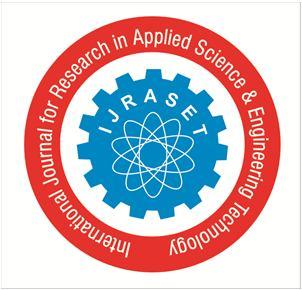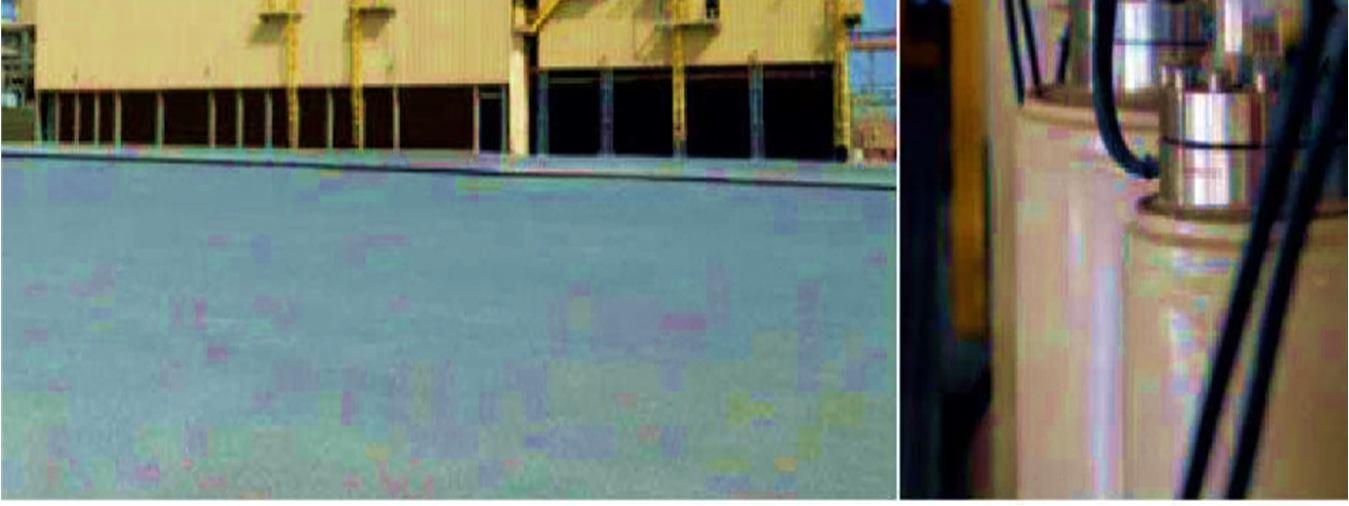
2321
IC Value: 45.98; SJ Impact Factor:

10 Issue IX Sep 2022 Available at www.ijraset.com


2321
IC Value: 45.98; SJ Impact Factor:

10 Issue IX Sep 2022 Available at www.ijraset.com
Wopara Onuoha Fidelis1 , Nnadikwe Johnson 2 , Ewelike Asterius Dozie3, Udechukwu Mathew Chidubem4
1Department of Petroleum Engineering, Rivers State University, Nigeria
H.O.D in Department of Petroleum and Gas Engineering, Imo State University, Nigeria
3H.O.D in Department of Agriculture and Environmental Engineering, Imo State University, Nigeria
4Department of Petroleum Engineering Federal University Technology, Imo State
Abstract: Sales gas generally contains barely 0.05 percent helium, making recovery uneconomical. Currently available commercial helium sources range from 0.3 to 8% helium from natural gas reserves, with 0.3 percent being the economic recovery limit. This article compares the technical and economic viability of manufacturing Grade-A liquefied helium from sales gas with low helium contents utilizing combined NGL/NRU/HRU technology.
Keywords: Helium, Evaluation, Economics, Project, Sales Gas, Thermodynamics
Helium is also produced as a by product of LNG production. After the methane and other hydrocarbons are liquefied, the helium and nitrogen remain gaseous and may be economically removed. Because of this, the end flash gas from an LNG plant tends to include 10 times the helium from the Qatar North Field, resulting in a helium concentration of 0.50 mole percent. At this concentration, classical stand alone helium recovery becomes cost effective, as used in Qatar LNG plants. In the absence of an LNG plant, a Nitrogen Recovery Unit (NRU) is required to concentrate the helium to a level suitable for purification and liquefaction. This adds to the project's expense. Alternatively, integrating the NGL/NRU/HRU decreases equipment count, optimizes temperature profiles, and minimizes recompression horsepower


This research focuses on maximizing thermodynamic and economic advantages of an integrated plant architecture to increase project viability. As shown in the diagrams below, a standalone and an integrated plant arrangement

Journal for Research in
Science & Engineering Technology (IJRASET)

ISSN: 2321 9653; IC Value: 45.98; SJ Impact Factor: 7.538 Volume 10 Issue IX Sep 2022 Available at www.ijraset.com
This results in high, moderate, and low pressure methane residual stream. This saves energy over combining an independent NGL backup system with a distinct nitrogen rejection unit. Less cool boxes and columns mean less recompression horsepower. The Barzan Gas Project, a joint venture between Qatar Petroleum and ExxonMobil Barzan Limited, will be the first in Qatar to use Combined Natural Gas Liquids/Nitrogen Rejection Unit (NGL/NRU) technology. A comparable feed gas composition (0.05%) and overall sales gas flow (1.4Bscfd) are used in this project.
Assuming a 95%+ ethane recovery rate, the feed compositions at the NGL Recovery Unit's output are shown in the following table. The gas is dry and devoid of mercury, with a CO2 concentration of 50 parts per million (ppm) and an H2S concentration of 4 parts per million (ppm).

As seen below, a standalone HRU may be installed downstream of an

and
of Sales

Factor
Factor 7.894
ISSN: 2321 9653; IC Value: 45.98; SJ Impact Factor: 7.538 Volume 10 Issue IX Sep 2022 Available at www.ijraset.com

The overhead gas from the NGL Recovery Unit must first travel through a Nitrogen Rejection Unit (NRU) before proceeding to Helium Purification and Liquefaction. The freestanding Helium Recovery Unit is described below. Variations in process explanations from various licensors



In the NRU, a high pressure pre fractionator precedes a low pressure NRU fractionator. The NRU feed is the Demethanizer's overhead, which is chilled in a cryogenic heat exchanger and sent to the Prefractionator for nitrogen enrichment. The prefractionator's bottom produces MP Sales Gas, while the prefractionator's overhead holds most of the helium. This vapor feeds the Low Pressure NRU Fractionator, which generates LP Sales Gas, nitrogen, and crude helium. The nitrogen may be utilized for sealing, blanketing, purging, and cooling while the remainder is vented to the atmosphere. The Sales Gas Compressors receive the MP and LP Sales Gas. Because the NRU reduces pressure, the duty needed for the Sales Gas Compressors is increased compared to the present design. The NRU's crude helium product is sent directly to the Helium Purification and Liquefaction Units.

To avoid freezing out contaminants in the liquefaction process, the NRU's crude helium must be upgraded to above 99 percent He before liquefaction. A PSA unit removes pollutants downstream of the NRU by condensation of H2O, CO2 and O2.

& Engineering Technology (IJRASET
ISSN: 2321 9653; IC Value: 45.98; SJ Impact Factor: 7.538 Volume 10 Issue IX Sep 2022 Available at www.ijraset.com


To the Helium Liquefaction Unit with pure helium. The Helium Liquefaction device has two compressing segments (high and low pressure) and a turbo expander equipped cold box. The helium cycle of compression, cryogenic expansion, and cryogenic heat transfer cools and liquefies the PSA unit's pure helium flow.
Produced liquid helium is stored in a tank. Recycled helium liquefaction tank vapor.

One provider recommended combining the Helium Recovery Unit with the NGL Recovery Unit, as seen in Figure 6. This integration may minimize overall equipment count and boost process efficiency. The feed stream is piped from Molsieve Beds to the integrated NGL/NRU Equipment
Also, it provides final separations of the methane residual streams and NGL products, and provides a “cooled” and “lean” feed to the high pressure column system. A part of the feed is utilized as a reboiler in the Demethanizer stage. A large amount is exchanged with NRU vapor product streams and partly condensed. A separator separates the bottom liquids from the partly condensed streams for the demethanizer.

As a result, a methane residue stream and a C2+NGL liquid bottom stream with 99 percent ethane recovery are produced. The HP Column, absorber stripper, works to separate and recover the extra ethane and heavier hydrocarbons while minimizing the nitrogen. The feed gas is then supplied to the NRU system, which begins with Prefractionator unit.
The NRU uses a Prefractionator to separate nitrogen and methane. This separation produces a methane rich liquid that transports any leftover NGL components to the demethanizer. The net overhead vapor is also nitrogen enriched and delivered to the NRU Fractionator.

The NGL/NRU unit's NRU Fractionator mechanism separates nitrogen from methane. The bottom methane goes to the demethanizer. The helium rich overhead nitrogen product is transported to the Crude Helium Separator. Airborne crude helium from the Crude Helium Separator heads for purification and liquefaction. The purification and liquefaction units will function as detailed in the separate process description.
Factor
Value:
10 Issue IX Sep 2022
Factor:
at

Fig 7: Process for Recovering Helium

In this research, the Total Installed Cost (TIC) estimations were based on equipment pricing and benchmarks from other projects. Cost estimates for bulks, piperacks, interconnections and buildings, transportation and construction management were generated based on the equipment costs supplied by the licensees. DCS/ESD/FGS and Flare were included in the screening TIC estimates as well as any items rejected by the licensors.
1) Estimation of Stand Alone Cost: The stand alone Helium Recovery Unit (HRU) has a CAPEX of $216 million. The Total Installed Cost of the Helium Recovery Unit and the cost of the sales gas compressors are included in this calculation


2) Estimation of Integrated Cost: The total cost of the Helium Recovery Unit is $249 million. The Helium Recovery Unit's TIC and the sales gas compressors are both included in this price.
B. Economics of the Project Revenue, CAPEX, OPEX, NPV, and IRR were estimated at the screening level for both stand alone and integrated options. The results are shown in the table below. CAPEX/OPEX was based on bids from technology suppliers. Section 1.6 provides the basis for the estimations
Fig 8: Grade A Real Price Trends in the Future

A helium (99.997%)
of power=7cents/kWh
rate=5%

Membrane technique for helium recovery from natural gas has been studied for many years, with multiple patents obtained. Several US government funded initiatives are actively working on developing membrane technology for economically recovering helium from marginal gas reserves with low helium contents. According to top technology vendors, there is no reference facility utilizing membranes for helium recovery.
Membranes are suitable for numerous processes. If helium recovery is the main objective, helium concentrations greater than 0.5 percent are necessary. The 500ppm helium sales gas is too low for the present economic recovery.
Even at 0.5 percent concentration, a multi stage design with separators and recirculation circuits is necessary. Even then, only a crude helium product is obtained, necessitating additional purification. The recovered helium is 30% helium, compared to 50 70 percent in most cases

& Engineering Technology (IJRASET
ISSN: 2321 9653; IC Value: 45.98; SJ Impact Factor: 7.538 Volume 10 Issue IX Sep 2022 Available at www.ijraset.com

To achieve a hybrid approach, crude helium recovery may be achieved using membrane technology, followed by cryogenic separation and liquefaction. In one European facility, only membranes are used to decrease helium concentration from 0.4 percent to 80 percent recovery in a 120 MMSCFD gas stream. The recovered gas will be sent to a helium refinery with additional capacity to handle the crude helium stream, therefore purity is not crucial to the customer. Membrane technology is not cost effective for this project, say two top providers. The low helium concentration and considerable gas flow need enormous membrane surface area

1) This feasibility study indicates that helium recovery from sales gas is not economically viable using conventional cryogenic technologies. The primary reason is that due to the low helium concentration, a NRU is needed to concentrate it to higher levels for economic removal.
2) Amongst the technology options considered in this study, the NGL/NRU/HR integration technology looks most promising. In this option the NRU is integrated with the NGL unit reducing CAPEX and OPEX as some equipment is eliminated and recompression costs reduced due to thermodynamic advantages
1) An integrated NGL/NRU/HRU Helium Plant can extract helium from sales gas.
2) A commercial helium extraction plant processing 260MMscfy of total gas feedstock costs $280MM. This plant's CAPEX is projected at $249MM.

3) OPEX for standalone and integrated alternatives is $34MM and $17MM, respectively.
4) At a helium price of $200/Mscf, the gross revenue is $17MM for standalone and $35MM for integrated.
5) At $200/Mscf, the NPV of such a project is $25MM for stand alone and $243MM for integrated alternatives. The IRRs are 6.0 and 13.2 percent.
6) In 2020, the Future Trend in Real Price of Grade A indicates helium at $230 240/Mscf.
7) Membrane technique is not possible owing to low helium concentration and huge gas volume. Also, a hybrid method including membranes to produce crude helium, followed by cryogenic purification and liquefaction, is not practicable.

I thank co authors for their expertise and assistance throughout all aspects of this research work.
Journal for Research in Applied Science & Engineering Technology (IJRASET)

ISSN: 2321 9653; IC Value: 45.98; SJ Impact Factor: 7.538

Volume 10 Issue IX Sep 2022 Available at www.ijraset.com
[1] Behling, R. D., Peinemann, K. V. and da Silva, L.B. (2001) Process for the separation/recovery of gases, US patent no. 6179900 B1.
[2] D’Amico, J., Reinhold, H.E.I. and Knaebel, K.S. (1996) Helium recovery, US patent no. 5542966.
[3] Daly, J.W. (2005) “Helium recovery from LNG.” International Petroleum Technology Conference, American Association of Petroleum Geologists (AAPG); the European Association of Geoscientists and Engineers (EAGE); the Society of Exploration Geophysicists (SEG); and the Society of Petroleum Engineers (SPE),
[4] J.A. Howell, editor. The Membrane Alternative: Energy Implications for Industry, Elsevier Science Publishing, Essex, UK, p. 176.
[5] Hudson, H.M., Wilkinson, J.D., Cuellar, K.T. and Pierce, M.C (2003), Integrated Liquids Recovery Technology Improves LNG Production Efficiency. 82nd Annual Convention of the Gas Processors Association. 2003. San Antonio, Texas.
[6] Lee, R. J., Yao, J., Chen, J.J. and Elliot, D.G. (2002), Enhanced NGL Recovery Utilizing Refrigeration and Reflux from LNG Plants, U.S. Patent 6,401,486.
[7] Wilkinson, J., Hudson, H., Cuellar, K. and Pitman, R. (2002), Efficiency through Integration. Hydrocarbon Engineering, 7(12): p. 23 26.
Factor
